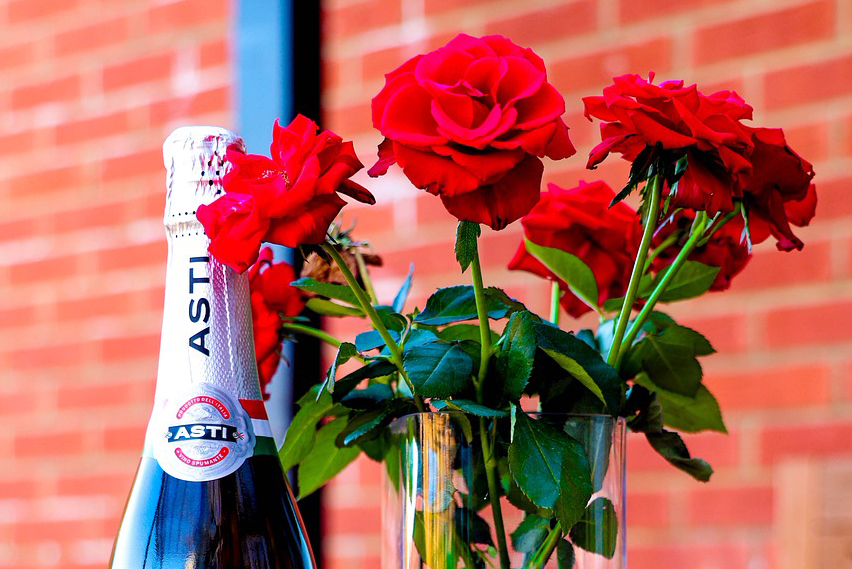
Part three: Sparkling wine – The Asti / Dioise Method
Undoubtedly in the majority of the world, wine tastes have gradually been shifting towards wines made in a dryer style. By far, the majority of sparkling wines are brut. Some are even made in drier styles than brut, for such as Brut Nature. Asti, then has somewhat drifted out of fashion on the international market, given that it tends to be somewhat sweeter. In many ways this is a real shame, because the grape variety Moscato Bianco which is the predominant variety in Asti can actually be quite expressive.
Typically, we find aromas of orange blossom, rose, peaches and grapes, a sweet, delicate palette and a creamy mousse, moderate acidity and often a perfumed style. This highly aromatic style is unusual in that most other sparkling wines use non-aromatic varieties. This means most base wines are quite bland. Not Asti. In this post, we explore why Asti is different from other sparkling wines and how the process of making it makes this the case.
Growing, harvesting, pressing
As we have already discovered, the primary variety in Asti is the Moscato Bianco grape. It often thrives best in chalky limestone, sandy loam and clay, and has good resistance to cold temperatures, but can also thrive in warm climates as far south as Sicily. The grape is early budding, late ripening and depending on the clone quite thin skinned. , It is, therefore, often harvested by hand. The juice tends to be less acidic than other grapes, which supports its use for making a sweeter style of wine. Once harvested and sorted grapes are lightly pressed, and the juice clarified and filtered.
No secondary fermentation
What makes the Asti unique is that it does not go through a secondary fermentation induced by adding a Tirage liquid. Instead, the grape is fermented (usually in a stainless steel tank and temperature controlled to a low temperature) with the vessel unsealed. This allows carbon dioxide to escape. Part way through the fermentation, however, the vessel is sealed (or it is transferred to a new sealed vessel). Here it will continue its fermentation until it reaches between 5 – 7% ABV. Because the vessel is sealed, the carbon dioxide dissolves into the wine creating the bubbles. Because the wine has residual sugar and the yeast have not converted it all to alcohol, there is no secondary fermentation required either in tank or in bottle. Instead the CO2 is trapped during the single fermentation.
Chilling, filtration and bottling
At 5-7% ABV the wine is chilled which halts the fermentation process, and then goes through a filtration process to filter out the remaining yeast. This prevents further fermentation occurring. The resulting wine can then be transferred into bottles under pressure in order to retain its pressure. From here a cork is inserted, wire cage added and a foil seal placed on the bottle, which is now ready for distribution.
Unique character
The process above leaves the wine with a number of characteristics which distinguish it from other sparkling wines. Firstly, the levels of sugar are higher as the wine is not fermented to dryness. This, and the generally slightly lower level of acidity, makes the wine typically light-bodied and sweet. Secondly, alcohol levels are lower making it more like a sparkling grape juice than a wine. It is a very grapey wine. That statement probably sounds ridiculous – of course wines are grapey! But actually we spend a lot of time describing other flavours in wine. Asti is a good example of a wine which actually have grapey flavours.
It is a style of wine which has gone out of fashion a little, so it is difficult to know where to place it for some people. One suggestion is to treat is as an aperitif or digestive, serving it prior to or following food. Its natural sweetness may well lend it pairing with some desserts. As a Brit, it likely also makes a perfect afternoon tea wine. And a wine for occasions when something too heavy is going to spoil the mood. In the UK the wine, like Lambrusco and to a lesser extent Riesling, has a pretty awful reputation. And yet there are bottles on every supermarket shelf which suggests that someone somewhere is still drinking it! In my view, you should give it a go too. You might just find something to take on your next picnic to replace the Prosecco! In the meantime, keep exploring this beautiful planet we live on, one glass at a time!